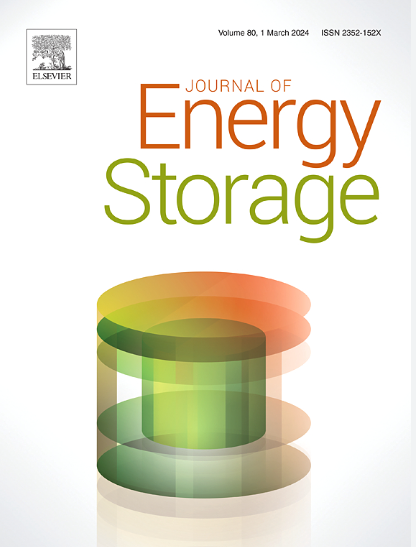Quantifying the role of ultrasonic welding and press contacts on electrical resistance for developing battery interconnects
IF 8.9
2区 工程技术
Q1 ENERGY & FUELS
引用次数: 0
Abstract
This paper investigates the comparative study of electrical resistance between press contact and ultrasonic welding techniques for similar and dissimilar Al and Cu combinations, which are primarily used in electric vehicle (EV) battery interconnects. The effect of surface roughness, pressure, and the number of nuggets on electrical resistance was quantified for press contact and ultrasonic welding. The results showed that Al![]() Al, Cu
Al, Cu![]() Al, and Cu
Al, and Cu![]() Cu tab-to-tab material combinations exhibited the ultrasonic welding exhibited up to 80 % reduction in electrical contact resistance in comparison to press contacts. The changes in resistance from single ultrasonic nugget to three ultrasonic nuggets for Al
Cu tab-to-tab material combinations exhibited the ultrasonic welding exhibited up to 80 % reduction in electrical contact resistance in comparison to press contacts. The changes in resistance from single ultrasonic nugget to three ultrasonic nuggets for Al![]() Al, Cu
Al, Cu![]() Al, and Cu
Al, and Cu![]() Cu combinations were 31.4 %, 9.5 % and 14.37 %, respectively. This multi-nugget configuration can significantly improve the performance and life of the battery joint when considering large-scale applications like energy storage systems and electric vehicles. A multiphysics model of electrical contact resistance was developed and verified with experimental results to predict the electrical behaviours for press contact and ultrasonic joints. The developed simulation models for press contacts and ultrasonic welding were able to predict the electrical resistance within 4 % - 27 % deviation from experimental results. Using a mathematically modelled case study, the paper also highlighted the effect of such electrical resistance offered by different joint configurations and its industrial importance. These findings revealed the importance of material selection, joint configuration, and joint strategy to reduce the resistance offered for niche applications like electric vehicles and energy storage systems.
Cu combinations were 31.4 %, 9.5 % and 14.37 %, respectively. This multi-nugget configuration can significantly improve the performance and life of the battery joint when considering large-scale applications like energy storage systems and electric vehicles. A multiphysics model of electrical contact resistance was developed and verified with experimental results to predict the electrical behaviours for press contact and ultrasonic joints. The developed simulation models for press contacts and ultrasonic welding were able to predict the electrical resistance within 4 % - 27 % deviation from experimental results. Using a mathematically modelled case study, the paper also highlighted the effect of such electrical resistance offered by different joint configurations and its industrial importance. These findings revealed the importance of material selection, joint configuration, and joint strategy to reduce the resistance offered for niche applications like electric vehicles and energy storage systems.

量化超声波焊接和压接点对电阻的作用,用于开发电池互连
本文对主要用于电动汽车电池互连的相似和不同铝铜组合材料的压接和超声焊接技术的电阻进行了比较研究。量化了表面粗糙度、压力和焊块数量对压接和超声焊接电阻的影响。结果表明,AlAl, CuAl和CuCu tab-to-tab材料组合在超声波焊接中,与压接接触相比,电接触电阻降低了80%。AlAl、CuAl和CuCu组合的单超声熔块与3超声熔块的阻力变化分别为31.4%、9.5%和14.37%。考虑到储能系统和电动汽车等大规模应用,这种多核配置可以显著提高电池接头的性能和寿命。建立了多物理场接触电阻模型,并通过实验验证了该模型的有效性。所建立的压力机触点和超声波焊接的仿真模型与实验结果的偏差在4% ~ 27%之间。通过一个数学建模的案例研究,本文还强调了不同接头结构提供的这种电阻的影响及其工业重要性。这些发现揭示了材料选择、接头配置和联合策略对于减少电动汽车和储能系统等利基应用的阻力的重要性。
本文章由计算机程序翻译,如有差异,请以英文原文为准。
求助全文
约1分钟内获得全文
求助全文
来源期刊

Journal of energy storage
Energy-Renewable Energy, Sustainability and the Environment
CiteScore
11.80
自引率
24.50%
发文量
2262
审稿时长
69 days
期刊介绍:
Journal of energy storage focusses on all aspects of energy storage, in particular systems integration, electric grid integration, modelling and analysis, novel energy storage technologies, sizing and management strategies, business models for operation of storage systems and energy storage developments worldwide.
 求助内容:
求助内容: 应助结果提醒方式:
应助结果提醒方式:


